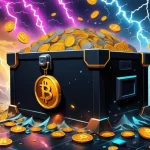XRP Supply Shock Looms? New ETFs Spark Hype and Skepticism in Slumping Market

XRP Supply Shock on the Horizon? Spot ETFs Stir Hopes and Doubts Amid Market Woes
New spot XRP ETFs from Bitwise and Canary Capital have hit the market, igniting speculation of a potential supply shock for this polarizing altcoin. While some pundits predict massive inflows and skyrocketing prices, tepid early results and a broader crypto slump cast doubt on the hype. Is this the spark XRP needs, or just another mirage in the desert of altcoin promises?
- ETF Rollout: Bitwise and Canary Capital launch spot XRP ETFs, with Grayscale and others lined up.
- Supply Shock Buzz: Analysts warn of shrinking XRP availability as ETF demand could surge.
- Price Reality: XRP trades at $1.91, down 2%, far from the lofty predictions of $220.
The Promise of XRP ETFs: A Gateway to Mainstream Adoption
The crypto space is witnessing a pivotal moment for XRP with the debut of spot exchange-traded funds (ETFs) from asset managers Bitwise and Canary Capital. These regulated investment products, approved for traditional markets, allow investors—think big players like hedge funds and pension funds, not just retail traders—to gain exposure to XRP’s price without the hassle of managing digital wallets or navigating crypto exchanges. This is a significant step for an altcoin often tied to Ripple, a company long embroiled in a legal tussle with the SEC over whether XRP qualifies as a security. Following in the footsteps of Bitcoin and Ethereum, whose ETF launches triggered massive price rallies, XRP’s foray into this space signals growing institutional interest and a potential shift toward broader acceptance.
History offers a compelling backdrop. When Bitcoin spot ETFs launched in 2021, the price surged from around $20,000 to over $60,000 within months, fueled by unprecedented capital inflows. Ethereum followed suit, with billions pouring into its ETFs and driving significant gains. If XRP mirrors even a fraction of this trajectory, the impact could be seismic. Upcoming launches add to the momentum—Grayscale’s spot XRP ETF is set for November 24 on NYSE Arca, as confirmed by Bloomberg analyst Eric Balchunas, while Franklin Templeton and 21Shares are poised to roll out their own funds in the coming weeks. For XRP, often sidelined in the shadow of Bitcoin’s dominance, this could be a defining push into the spotlight.
Supply Shock: Hype or Legitimate Concern?
At the heart of the buzz is the idea of a supply shock—a sudden reduction in available XRP on the open market due to spiking demand, which could drive prices upward. Crypto pundit Cobb has been vocal about this possibility, warning with stark clarity:
“A supply shock is coming for XRP.”
The logic is straightforward: as ETFs attract institutional money, these funds purchase and hold large quantities of XRP, locking it away in storage and reducing the circulating supply for everyday trading. With less XRP available on exchanges, even modest demand could create significant price pressure. For deeper insights into this possibility, check out this analysis on why a supply shock might be looming for XRP.
But let’s unpack this further. XRP’s supply dynamics are unique due to Ripple’s escrow system, where 55 billion XRP—roughly half the total supply—are held in reserve and released monthly at a controlled rate of about 1 billion. This mechanism, designed to prevent market flooding, could theoretically mitigate a supply shock by ensuring a steady trickle of new coins. However, if ETF inflows reach the levels some predict, even these releases might not keep pace. Chad Steingraber, another vocal analyst, paints a dramatic picture:
“Funds taking in a net inflow of a billion daily, with 500 million of the altcoin sent to storage daily… the token’s price won’t remain at $2.”
It’s a bold claim, but early data from SoSo Value shows inflows far below this fantasy—Canary Capital peaked at $245 million on launch day before dwindling sharply. So, while the supply shock thesis isn’t pure fiction, it’s far from a done deal.
Market Reality Check: Why the Hype Isn’t Sticking Yet
Despite the fanfare, the numbers tell a sobering story. XRP is currently trading at $1.91, down over 2% in the last 24 hours per CoinMarketCap data, reflecting no immediate ETF-driven euphoria. Broader crypto market weakness plays a big role—bearish sentiment, fueled by macroeconomic pressures like rising interest rates and inflation fears, has dampened investor appetite across the board. Bitcoin and Ethereum aren’t immune either, with both seeing reduced ETF inflows in recent weeks. For XRP, already a token with a rocky reputation among some crypto purists, this environment isn’t exactly fertile ground for a breakout.
Then there are the wild price predictions. Steingraber doubles down with a forecast of XRP hitting $220, claiming:
“The altcoin’s price could rally to as high as $220 as these funds continue to accumulate more coins.”
Let’s ground ourselves here—that’s a pipe dream detached from any semblance of current market fundamentals. XRP struggling to hold $2 while the market bleeds is a far cry from a 100x surge. Even Canary Capital CEO Steven McClurg’s more measured optimism of
“the funds could take in $10 billion in inflows in their first month, depending on the market conditions,”
comes with a glaring caveat. Without a dramatic shift in sentiment, these figures feel more like marketing than reality. We’re not here to peddle moonshots—our stance is clear: cut the BS and focus on the data.
XRP’s Polarizing Legacy: A Double-Edged Sword
XRP has never been a neutral player in the crypto arena. To Bitcoin maximalists, it’s often derided as a “banker coin” due to Ripple’s centralized control over much of the supply and its focus on partnering with traditional financial institutions. This flies in the face of the decentralization ethos that Bitcoin champions. On the flip side, proponents argue XRP fills a crucial niche—its design for fast, low-cost cross-border payments via RippleNet offers practical utility that Bitcoin, with its slower transactions and higher fees, can’t match. ETFs could tip the scales in this debate, lending XRP a veneer of legitimacy through institutional backing. But lingering regulatory uncertainty from Ripple’s ongoing SEC lawsuit, despite partial legal wins, still spooks some investors. Will Wall Street’s embrace outweigh the baggage, or will skepticism persist?
What’s Next for XRP ETFs and Their Impact?
The coming weeks are critical. With Grayscale’s ETF launch on November 24 and others from Franklin Templeton and 21Shares on the horizon, we’ll soon see whether institutional interest can overcome market headwinds. Best-case scenario: inflows scale to billions as predicted, tightening supply and sparking a rally that echoes Bitcoin’s ETF-fueled ascent. Worst-case: the crypto winter drags on, and XRP ETFs become a footnote as investors shy away. There’s also the wild card of broader market recovery—if Bitcoin regains steam, altcoins like XRP often ride the wave. For now, the smart move is to watch the numbers—net inflows, trading volume, and price action—rather than getting swept up in speculative fever dreams of $220 valuations.
XRP’s Place in the Crypto Revolution
Even with its flaws, XRP’s ETF moment could mark a step forward in the broader push to disrupt traditional finance. While it may not embody the pure decentralization of Bitcoin—a cornerstone of our vision at Let’s Talk, Bitcoin—these funds accelerate mainstream crypto adoption, flaws and all. This aligns with the spirit of effective accelerationism, where rapid innovation, even if imperfect, chips away at the status quo. XRP might not be the poster child for privacy or freedom, but its potential to bridge old and new financial systems carves out a unique role. As this experiment unfolds, we’ll keep a critical eye on whether it delivers real change or just more noise in an already chaotic space.
Key Questions and Takeaways on XRP’s ETF Journey
- What’s fueling the XRP supply shock speculation?
Spot XRP ETFs from Bitwise and Canary Capital, with more launching soon, could drive demand and lock up supply, reducing what’s available on exchanges. - Why are XRP ETF inflows underwhelming so far?
A crypto market downturn, compounded by macroeconomic pressures like high interest rates, has curbed investor enthusiasm, with early peaks like $245 million quickly fading. - Can XRP replicate Bitcoin and Ethereum ETF price surges?
It’s possible with massive inflows, as seen with BTC and ETH, but XRP’s regulatory hurdles and current market weakness make direct comparisons uncertain. - Are predictions like $220 for XRP grounded in reality?
No, such figures seem wildly speculative given XRP’s $1.91 price and struggling market conditions; they rely on unrealistic inflow assumptions. - What’s the next milestone for XRP ETFs?
Grayscale’s launch on November 24, alongside others, could be a turning point—strong inflows might validate the supply shock idea, while apathy could debunk it. - How does XRP fit into the broader crypto mission?
Despite centralization critiques, XRP’s ETF push could hasten mainstream adoption, supporting the drive to disrupt traditional finance, even if it’s not Bitcoin-pure.



